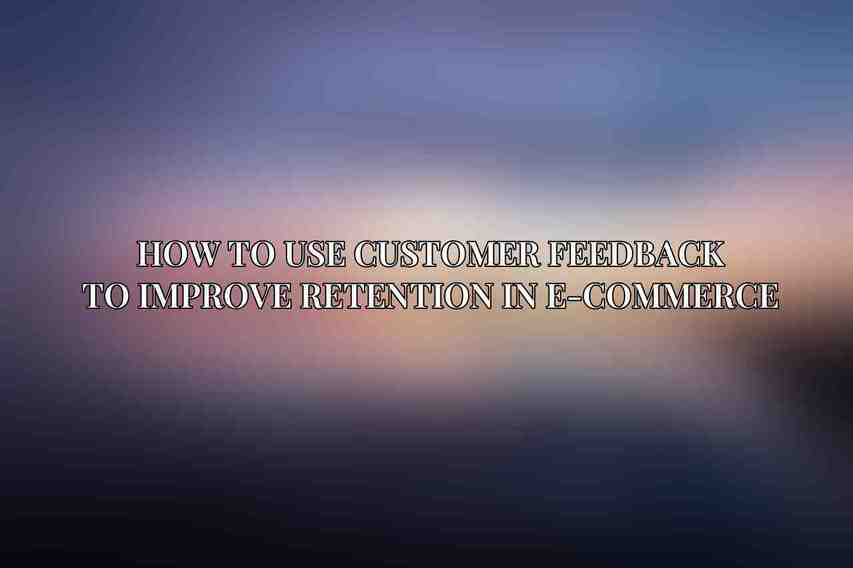Customer feedback plays a pivotal role in the success of e-commerce businesses by directly impacting customer loyalty. Both positive and negative feedback significantly influence how customers perceive a brand and whether they choose to continue their relationship with a company. Positive feedback can build trust and loyalty, leading to repeat purchases and positive word-of-mouth, while negative feedback can result in customer churn and a damaged brand reputation. Thus, actively soliciting and addressing feedback is crucial for fostering customer loyalty and retention in the competitive e-commerce world.
Feedback serves as a valuable tool for e-commerce businesses to pinpoint areas that require improvement. By listening to customer feedback, companies gain insights into what aspects of their products, services, or overall customer experience may be lacking or falling short of expectations. Whether it’s product quality, shipping times, website usability, or customer service, feedback provides a roadmap for identifying and addressing pain points to enhance the overall customer experience.
Regular feedback collection is an essential practice for e-commerce businesses committed to ongoing retention efforts. The dynamic nature of the market and evolving customer expectations necessitate a continuous feedback loop to stay attuned to changing preferences and needs. Engaging customers through feedback mechanisms not only demonstrates a commitment to their satisfaction but also allows businesses to adapt and evolve in response to feedback, thus increasing customer retention rates over time.
Collecting Customer Feedback Effectively

To gather actionable insights and leverage customer feedback for retention, e-commerce businesses must employ various methods of collection. Surveys, email requests, and social media platforms are common channels through which businesses can solicit feedback from their customer base. Surveys, whether conducted on-site or via email, enable businesses to ask specific questions and gather structured feedback. Email requests for feedback can be strategically timed post-purchase to capture customer sentiments while social media platforms provide a more informal and interactive space for customers to share their thoughts.
Creating effective feedback surveys involves employing best practices to ensure the questions are clear, relevant, and actionable. Utilizing a mix of closed-ended (multiple-choice, rating scales) and open-ended questions can provide both quantitative and qualitative feedback. It’s important to keep surveys concise to encourage completion and provide incentives, such as discounts or loyalty points, to boost participation rates.
Encouraging customer participation in feedback collection requires proactive engagement and communication. Companies can incentivize feedback submission by offering rewards, engaging in two-way communication to show customers their opinions matter, and highlighting how feedback-driven changes benefit the overall customer experience. By making the feedback process interactive and rewarding, businesses can increase engagement and gather more comprehensive feedback data for retention strategies.
Analyzing Customer Feedback for Valuable Insights

Analyzing customer feedback is a critical step in extracting valuable insights that can drive retention strategies. By identifying common themes and patterns in feedback, businesses can uncover recurring issues or preferences shared by customers. These themes can highlight areas of strength to leverage and areas for improvement to address, ultimately enhancing the overall customer experience.
Utilizing both qualitative and quantitative analysis methods is key to extracting meaningful data from customer feedback. Qualitative analysis involves categorizing and summarizing open-ended responses to reveal underlying sentiments and preferences. Quantitative analysis, on the other hand, uses statistical tools to measure trends, correlations, and customer satisfaction scores. The combination of both approaches provides a comprehensive view of customer feedback, allowing businesses to make data-driven decisions.
Employing advanced techniques such as sentiment analysis and text mining can offer deeper insights into customer feedback. Sentiment analysis tools analyze the tone and context of customer sentiments expressed in feedback, categorizing them as positive, negative, or neutral. Text mining techniques sift through large volumes of customer comments to uncover hidden insights and trends that may not be immediately apparent, enabling businesses to gain a deeper understanding of customer perceptions and preferences.
Implementing Feedback to Drive Retention
Implementing a feedback action plan based on thorough analysis is crucial for leveraging customer feedback to improve retention. The action plan should outline specific steps and initiatives derived from customer feedback insights. Prioritizing feedback based on its potential impact on retention and feasibility of implementation ensures that resources are allocated effectively to address the most critical issues identified through feedback analysis.
Implementing specific changes and enhancements based on customer input demonstrates a commitment to customer satisfaction and retention. Whether it involves product improvements, service enhancements, or operational changes, acting on customer feedback in a timely manner shows customers that their voices are heard and valued. By enacting tangible changes informed by feedback, e-commerce businesses can strengthen customer relationships and loyalty, ultimately driving retention and long-term growth.
Best Practices for Analyzing Customer Feedback for Retention
Establishing clear goals and objectives for feedback analysis is essential to ensure that insights are aligned with retention strategies. By defining key performance indicators and success metrics upfront, businesses can focus their analysis efforts on areas directly impacting customer retention. Regularly monitoring and tracking feedback data over time allows businesses to measure the effectiveness of implemented changes and adapt strategies as needed to continuously improve retention efforts.
Involving multiple stakeholders in feedback analysis and implementation fosters a collaborative approach to customer feedback management. By engaging cross-functional teams, including customer service, marketing, product development, and operations, businesses can gain diverse perspectives on feedback insights and ensure a coordinated effort to drive retention. Utilizing technology and software solutions for efficient feedback analysis streamlines the process, enabling businesses to manage and analyze large volumes of feedback data more effectively and derive actionable insights at scale. Learn more about Top Customer Loyalty Programs for E-commerce Optimization
Case Studies and Examples
Successful Examples of Companies Using Customer Feedback for Retention
Amazon: The e-commerce giant regularly collects customer feedback through post-purchase surveys and product reviews. By analyzing feedback data, Amazon identifies trends in customer preferences and tailors product recommendations and services to enhance customer retention.
Zappos: Known for its exceptional customer service, Zappos utilizes feedback to improve its support processes and product offerings. By actively listening to customer feedback and implementing changes based on insights, Zappos has built a loyal customer base that values the brand’s commitment to satisfaction.
Real-World Case Studies Demonstrating the Effectiveness of Feedback Analysis
Netflix: Through data analysis of user viewing habits and feedback on content preferences, Netflix continually refines its content recommendations and personalization algorithms. This feedback-driven approach has contributed to Netflix’s high customer retention rates and subscriber growth.
Airbnb: By soliciting feedback from both hosts and guests, Airbnb collects valuable insights on user experiences and preferences. This feedback loop informs platform enhancements and service improvements, driving customer satisfaction and retention on the platform. Check this blog on Mastering Email Marketing Strategies to Boost E-commerce Customer Retention
Insights and Best Practices from Industry Leaders
Industry leaders emphasize the importance of listening to customers, acting on feedback, and continuously evolving based on insights. By prioritizing customer feedback and incorporating it into strategic decision-making processes, businesses can build lasting relationships with customers and differentiate themselves in a competitive market.
leveraging customer feedback is a powerful strategy for improving retention in e-commerce. By understanding the impact of feedback on customer loyalty, collecting feedback effectively, analyzing insights, and implementing feedback-driven changes, businesses can enhance the overall customer experience and drive long-term retention. Establishing best practices for feedback analysis, involving stakeholders, and utilizing technology further amplify the benefits of customer feedback for retention strategies. Real-world examples and case studies demonstrate the tangible outcomes of integrating customer feedback into business operations. Ultimately, prioritizing ongoing feedback collection and analysis is key to creating a customer-centric approach that fosters loyalty and growth in the e-commerce sector.
Frequently Asked Questions
Why is customer feedback important in e-commerce?
Customer feedback is crucial in e-commerce as it provides valuable insights into customer preferences and pain points, helping businesses understand what works well and what needs improvement. Learn more about Ultimate Guide to Improving E-commerce Customer Service
How can e-commerce businesses collect customer feedback?
E-commerce businesses can gather customer feedback through surveys, feedback forms on their website, social media channels, online reviews, and customer support interactions.
What are some common customer feedback metrics used in e-commerce?
Common customer feedback metrics include Net Promoter Score (NPS), Customer Satisfaction Score (CSAT), Customer Effort Score (CES), and feedback sentiment analysis.
How can e-commerce businesses analyze and interpret customer feedback data?
E-commerce businesses can analyze customer feedback data by identifying trends, common themes, and patterns, and then using these insights to make informed decisions to improve their products and services.
What are some effective strategies to use customer feedback to improve retention in e-commerce?
Some effective strategies include implementing changes based on customer feedback, personalizing the customer experience, addressing negative feedback promptly, and rewarding loyal customers for their feedback and support.

